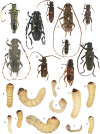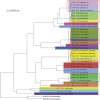Identification of wood-boring beetles (Cerambycidae and Buprestidae) intercepted in trade-associated solid wood packaging material using DNA barcoding and morphology
- PMID: 28091577
- PMCID: PMC5238391
- DOI: 10.1038/srep40316
Identification of wood-boring beetles (Cerambycidae and Buprestidae) intercepted in trade-associated solid wood packaging material using DNA barcoding and morphology
Abstract
Global trade facilitates the inadvertent movement of insect pests and subsequent establishment of populations outside their native ranges. Despite phytosanitary measures, nonnative insects arrive at United States (U.S.) ports of entry as larvae in solid wood packaging material (SWPM). Identification of wood-boring larval insects is important for pest risk analysis and management, but is difficult beyond family level due to highly conserved morphology. Therefore, we integrated DNA barcoding and rearing of larvae to identify wood-boring insects in SWPM. From 2012 to 2015, we obtained larvae of 338 longhorned beetles (Cerambycidae) and 38 metallic wood boring beetles (Buprestidae) intercepted in SWPM associated with imported products at six U.S. ports. We identified 265 specimens to species or genus using DNA barcodes. Ninety-three larvae were reared to adults and identified morphologically. No conflict was found between the two approaches, which together identified 275 cerambycids (23 genera) and 16 buprestids (4 genera). Our integrated approach confirmed novel DNA barcodes for seven species (10 specimens) of woodborers not in public databases. This study demonstrates the utility of DNA barcoding as a tool for regulatory agencies. We provide important documentation of potential beetle pests that may cross country borders through the SWPM pathway.
Figures






References
-
- Hulme P. E. Trade, transport and trouble: managing invasive species pathways in an era of globalization. J. Appl. Ecol. 46(1), 10–18 (2009).
-
- International Plant Protection Convention (IPPC). International standards for phytosanitary measures: Regulation of wood packaging material in international trade, Publ. No. 15. Food and Agriculture Organization of the United Nations, Rome, Italy (2016).
-
- Haack R. A., Law K. R., Mastro V. C., Ossenbruggen S. & Raimo B. J. New York’s battle with the Asian longhorned beetle. J. For. 95(12), 11–15 (1997).
-
- Bové J. M. Huanglongbing: a destructive, newly emerging, century-old disease of citrus. J. Plant Pathol. 88(1), 7–37 (2006).
-
- Holzmuller E. J. & Jose S. Invasion success of cogongrass, an alien C4 perennial grass, in the southeastern United States: exploration of the ecological basis. Biol. Invasions 13(2), 435–442 (2011).
Publication types
MeSH terms
LinkOut - more resources
Full Text Sources
Other Literature Sources

